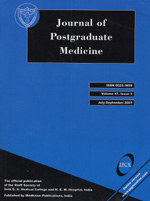
|
Journal of Postgraduate Medicine
Medknow Publications and Staff Society of Seth GS Medical College and KEM Hospital, Mumbai, India
ISSN: 0022-3859
EISSN: 0022-3859
Vol. 55, No. 3, 2009, pp. 180-184
|
 Bioline Code: jp09055
Bioline Code: jp09055
Full paper language: English
Document type: Research Article
Document available free of charge
|
|
|
Journal of Postgraduate Medicine, Vol. 55, No. 3, 2009, pp. 180-184
| en |
Evaluation of intracranial space-occupying lesion with Tc99m-glucoheptonate brain single photon emission computed tomography in treatment-naïve patients
Jaiswal, S.; Barai, S.; Rajkumar; Gambhir, S.; Ora, M. & Mahapatra, A. K.
Abstract
Background : Glucoheptonate is a glucose analog with strong affinity for neoplastic brain tissues. Though extensively used as a tracer for detection of brain tumor recurrence, it′s utility for characterization of intracranial lesions as neoplastic or otherwise has not been evaluated in treatment-naοve patients. Aim : The study was conducted to determine if glucoheptonate has sufficient specificity for neoplastic lesions of brain so that it can be utilized as a single photon emission computed tomography (SPECT)-tracer for differentiating neoplastic intracranial lesions from non-neoplastic ones in treatment-naοve patients. Settings and Design : A cross-sectional analysis of treatment-naοve patients with intracranial space-occupying lesion done in a tertiary care hospital. Materials and Methods : Fifty-four consecutive patients with clinical and radiological features of space-occupying lesion were included in this study. Glucoheptonate brain SPECT was performed before any definitive therapeutic intervention. Histopathological verification of diagnosis was obtained in all cases. Statistical Analysis Used : Descriptive statistics and student′s ′t′ test. Result : Increased glucoheptonate uptake over the site of radiological lesion was noted in 41 patients and no uptake was noticed in 13 patients. Histopathology of 12 out of the 13 glucoheptonate non-avid lesions turned out to be non-neoplastic lesion; however, one lesion was reported as a Grade-2 astrocytoma. Histology from all the glucoheptonate concentrating lesions was of mitotic pathology. The sensitivity, specificity and accuracy of glucoheptonate for neoplastic lesion was 97.6%, 100% and 98.1%. Conclusions : Glucoheptonate has high degree of specificity for neoplastic tissues of brain and may be used as a tracer for SPECT study to differentiate neoplastic intracranial lesions from non-neoplastic ones.
Keywords
Glucoheptonate, intracranial space-occupying lesions, single photon emission computed tomography
|
| |
© Copyright 2009 Journal of Postgraduate Medicine.
Alternative site location: http://www.jpgmonline.com
|
|
